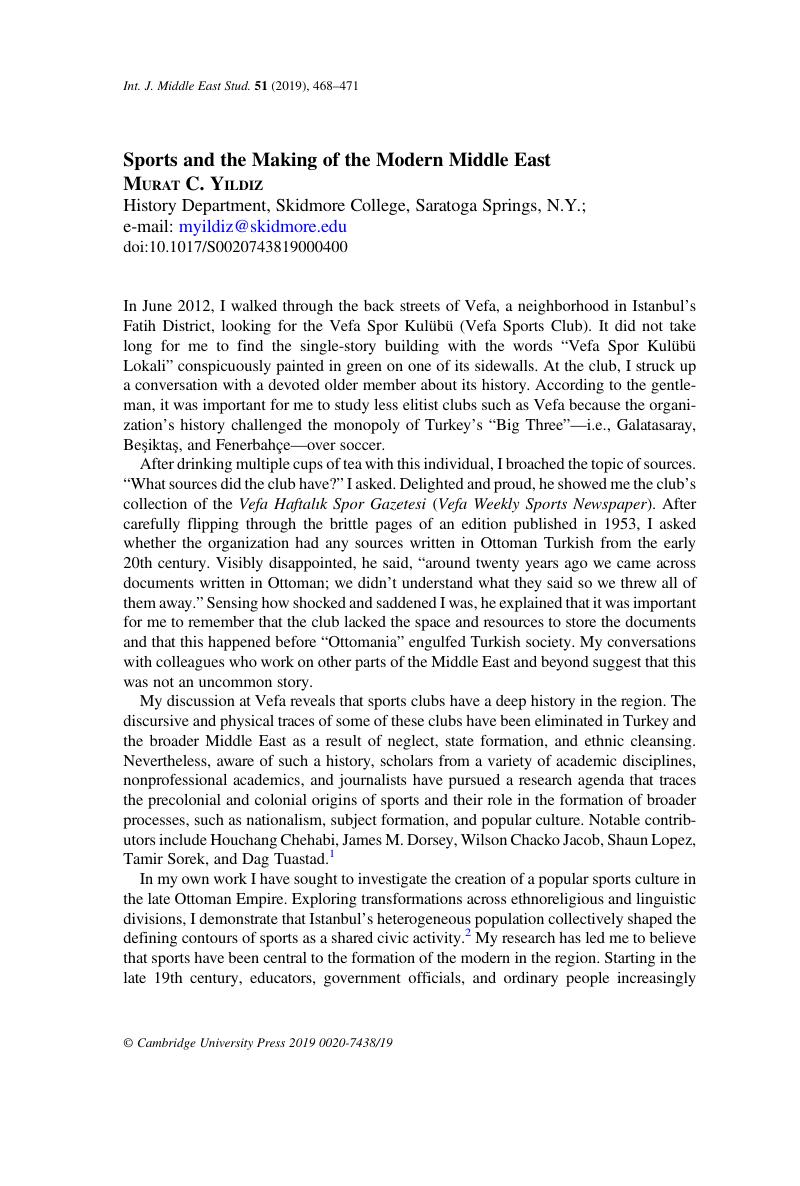Published online by Cambridge University Press: 17 June 2019

1 Chehabi, Houchang, “The Juggernaut of Globalization: Sport and Modernization in Iran,” The International Journal of the History of Sport 19 (2010): 275–94CrossRefGoogle Scholar; Dorsey, James M., The Turbulent World of Middle East Football (London: C. Hurst & Co, 2017)Google Scholar; Jacob, Wilson Chacko, Working Out Egypt: Effendi Masculinity and Colonial Modernity, 1870–1940 (Durham, N.C.: Duke University Press, 2011)CrossRefGoogle Scholar; Lopez, Shaun, “Football as National Allegory: Al-Ahram and the Olympics in 1920s Egypt,” History Compass (2009): 282–305CrossRefGoogle Scholar; Sorek, Tamir, Arab Football in a Jewish State: The Integrative Enclave (Cambridge: Cambridge University Press, 2007)Google Scholar; Tuastad, Dag, “The Political Role of Football for Palestinians in Jordan,” in Entering the Field: New Perspectives on World Football, ed. Armstrong, Gary and Giulianotti, Richard (Oxford: Berg Publishers, 1997)Google Scholar.
2 Murat C. Yıldız, “Strengthening Male Bodies and Building Robust Communities: Physical Culture in the Late Ottoman Empire” (PhD diss., University of California, Los Angeles, 2015); Murat C. Yıldız, “Mapping the ‘Sports Nahda’: Toward a History of Sports in the Modern Middle East,” in Sports, Society, and Politics in the Middle East, ed. Danyel Tobias Reiche and Tamir Sorek (London: C. Hurst & Co, forthcoming).
3 Provence, Michael, The Last Ottoman Generation and the Making of the Modern Middle East (Cambridge: Cambridge University Press, 2017)CrossRefGoogle Scholar; Schayegh, Cyrus, The Middle East and the Making of the Modern World (Cambridge, Mass.: Harvard University Press, 2017)CrossRefGoogle Scholar; Falb-Kalisman, Hilary, “‘The Next Generation of Cultivators’: Teaching Agriculture in Iraq, Palestine and Transjordan (1920–1960),” Histoire De L'éducation no. 148 (2019): 143–64Google Scholar.
4 Prestel, Joseph Ben, Emotional Cities: Debates on Urban Change in Berlin and Cairo, 1860–1910 (New York: Oxford University Press, 2017), 179CrossRefGoogle Scholar; “Nadi,” al-Hilal (1 May 1904), 538.
5 Prestel, Emotional Cities, 179; “Nadi,” al-Hilal (1 May 1904), 538.
6 On at least one very early occasion in the Maghrib, sports and music converged significantly. See Chris Silver, “Saoud l'Oranais – Gheniet U.S.M.O. – Polyphon, 1934,” Gharamophone, accessed 10 April 2019, https://gharamophone.com/2019/04/10/saoud-loranais-gheniet-u-s-m-o-polyphon-1934/?fbclid=IwAR0ut7QSbWbwd8NUMzUhOqM2NjH0t4G_rKWshnboqJGrnsRjf_Xe4U8FICE